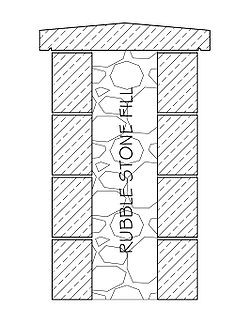Rubble masonry



Rubble masonry or rubble stone is rough, uneven building stone not laid in regular courses.[1][2] It may form an outer surface of a wall, or fill the core of a wall which is faced with unit masonry such as brick or ashlar. Some medieval cathedral walls have outer shells of ashlar with an inner backfill of mortarless rubble and dirt.
Square rubble masonry
[edit]This section needs expansion with: cited content on precisely what square rubble Masonry is, with appropriate photos. You can help by adding to it. (October 2025) |
Square rubble masonry consists of ashlar stones[citation needed] set in mortar, that make up the outer surface of a wall.[dubious – discuss]
History
[edit]The Sadd el-Khafara dam (2900–2600 BC) in Wadi Al-Garawi near Helwan in Egypt, is 14 meters high, filled with rubble masonry, and clad in unmortared stepped ashlar stones.[3]
The Greeks called the technique of constructing two parallel walls filled with a core of rubble or other infill emplekton,[4][5] notably used erecting defensive walls of their poleis.
The Romans made extensive use of rubble masonry, calling it opus caementicium, after the name (caementicium) given to the filling between two revetments. The technique continued to be used over the centuries, particularly for defensive walls and large works during medieval times.
In contrast, modern construction frequently uses cast concrete with an internal steel reinforcement, which allows for greater elasticity and provides excellent static and seismic resistance.[6]
See also
[edit]- Gabion—Metal cages filled with stones
- Snecked masonry—Masonry made of mixed sizes of stone but in regular courses
- Wattle and daub—Conceptually analogous to rubble within ashlar in the sense that a frame is filled in with a filler material
References
[edit]- ^ Fleming, Honour, & Pevsner. A Dictionary of Architecture.
- ^ "Rubble masonry". Encyclopædia Britannica. Retrieved 23 March 2023.
- ^ Robert B. Jansen (1988). Robert B. Jansen, ed. Advanced dam engineering for design, construction, and rehabilitation Springer.
- ^ RA Tomlinson (1961). "Emplekton Masonry and 'Greek Structura'". The Journal of Hellenic Studies Vol. 81. pp. 133–140.
- ^ Nic Fields & Brian Delf. Ancient Greek fortifications 500–300 BC. Osprey Publishing, 2006.
- ^ A. Acocella (1989). The Architecture of Brick Facing. Rome.
